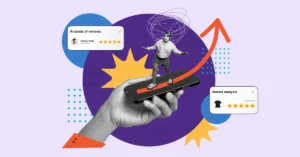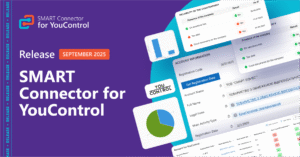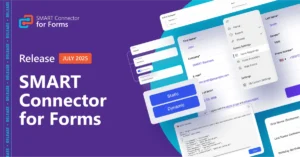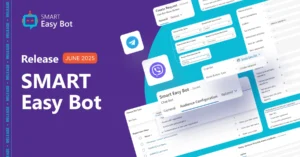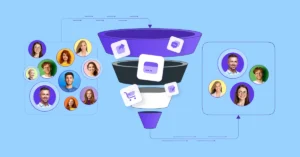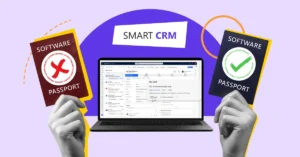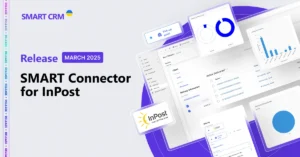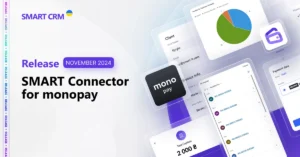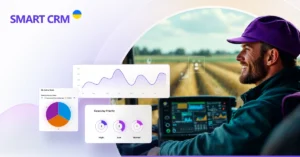Customer Experience: the journey from a potential customer to a loyal ambassador
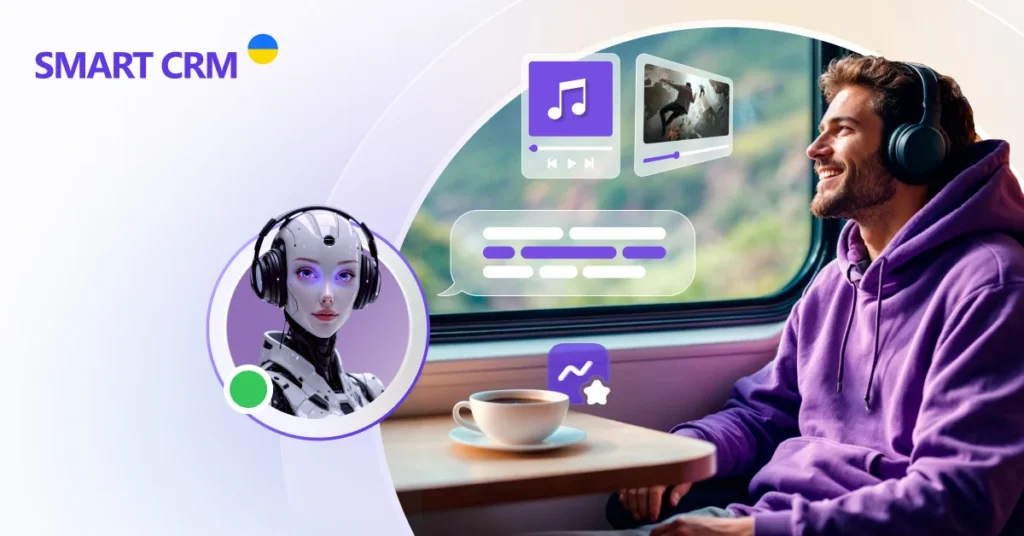
Happy customers are your biggest advocates and can become your most successful sales team.
The modern market offers customers a variety of products and services, creating high competition between companies. If before customers bought a product for the sake of the product, now they also come for a unique customer experience. Consumers care about everything that comes along with their interaction with the company: the type of brand, the culture and environmental friendliness of production, trendiness and social component, personalized offers, etc.
Statistics from McKinsey show that companies implementing hyper-personalized strategies can increase their revenues by 10-15% due to a more accurate accounting of the needs of each customer. At the same time, the costs of attracting new customers are reduced on average by 50%. Interestingly, now more than 70% of customers expect a personalized approach and even get irritated if this is not provided to them. So, how can companies meet the needs of a modern audience?
Providing perfect customer experience is like organizing an unforgettable train journey. Imagine your customer boarding a train car where everything is impeccable: a perfectly clean compartment, comfortable seats, and tea served exactly when needed. The conductor knows the passenger’s name, their preferences, maybe even the song that will be playing in the background. And if something goes wrong, it will be discreetly corrected before the customer even notices. This is the kind of customer journey that modern CRM systems provide, which can be integrated with a variety of analytics tools and AI technologies. They allow you to take into account every turn on the customer’s path from attraction to purchase and after-sales service. Thanks to these tools, a company can turn interaction with consumers into a journey that they will want to repeat again and again.
We invite you to a detailed overview of the capabilities of CRM systems that can provide an excellent customer experience thanks to such functions as:
- 360 customer vision and detailed audience segmentation,
- Building a Customer Journey Map,
- Creating campaigns for new and current customers,
- Improved customer service performance metrics,
- Countless integrations to scale your business,
- Keeping up with modern market trends.
The Magic of Prediction or Hyperpersonalization: the secret to effective customer engagement in the digital age

Hyperpersonalization is created through deep data analysis: CRM systems, social media integrations, and AI help collect all the important aspects of a customer’s life. This allows businesses to not only adapt their offers to individual preferences, but also dynamically change them in real time, responding to current user needs. This technique goes beyond standard segmentation: algorithms take into account not only past purchases or user behavior, but also social media data, audience preferences, context, and even emotional state. This approach allows you to anticipate customer needs and offer solutions even before they realize what exactly they need. The benefits for businesses are obvious: increased conversion, an increase in the average check, and an expansion of the customer base thanks to personalized recommendations. So how can you achieve hyperpersonalization when creating a holistic customer experience? Let’s take a closer look at several techniques:
- 360° customer portrait: The concept of consolidating data from different points of contact with the customer in one place. This view gives your team an idea of the customer’s unique relationship with the company, its products or services. Out-of-the-box solutions such as SMART CRM and Microsoft Dynamics 365 Customer Insights offer automation of most of the processes associated with creating a 360° portrait. For example, a business benefit is collecting and organizing customer information on a single platform with access for all company employees, preventing confusion in interactions. Integrations allow you to analyze transactions, support requests and customer preferences, thanks to which AI can identify patterns in their behavior. Another important part of a 360° customer view is managing omnichannel interactions, because customers expect the same service regardless of the channel they use. And thanks to a single database of information, users do not need to re-enter their data or re-submit requests when they switch to another communication channel.
- Customer segmentation: Audiences are always looking for a niche close to them. For example, today advertising from bloggers with millions of followers is less effective, because they have very different audiences subscribed to them. On the contrary, “small” bloggers usually have subscribers with similar views and preferences, so it is easier to select advertising that is relevant to their needs. Therefore, it is important for businesses to have tools that consider the smallest factors and find micro-connections between different types of consumers. Segmentation within the framework of hyper-personalization considers not only standard distribution factors (for example, demographic, geographic, professional categories), but also closer connections (psychographics, personal preferences, subscriptions in social networks, behavioral characteristics, pain points, etc.). Surveys, observations, data analysis, reviews and personal conversations will allow the company to form segments that are relevant to its offers, ensuring a high level of personalization for customers. The main thing is to maintain a balance so that users do not get the feeling that they are being watched.
- Hypothesis testing: Even the most accurate forecast from artificial intelligence cannot fully predict whether the customer will like a new marketing campaign. For this, there are hypotheses – short, precisely formulated statements about the user, product or niche. There are several ways to test these hypotheses, such as A/B or ICE. The A/B method is based on comparing two or more variants of one element in a marketing context to determine which variant leads to the best results. This testing can be used to check the relevance of content, the effectiveness of CTAs, and design solutions. The ICE method evaluates the hypothesis by three parameters: Impact, Confidence, and Effort. For example, how an offer can change the quality of customer experience, whether it has brought results in the past, and how many resources will be spent on it. High-quality hypothesis testing allows you to build marketing campaigns more effectively and personalize your approach to different customer segments.
To make sure that the theory does not remain just a theory, we suggest taking a detailed look at how to create a personalized customer portrait step by step:
For example, your company that integrates ERP systems has a new customer — Orest, 27, a manager of a bakery chain. His request is to implement a system for managing inventory, logistics, and finances. You accepted his request through a telephony application integrated into your CRM — thus, you already have all the customer data in a single database, which will allow other operators not to ask for his information again. All channels through which the customer can communicate with the company are also integrated into one system. Having collected Orest’s basic data, you create a customer profile and distribute it into the required segment — for example, “B2B customers of medium-sized businesses, age category from 25 to 35 years old, start-up business with an emphasis on marketing”. Based on the history of interactions, your CRM system generates expected customer actions: negotiating the terms of the contract, demonstrating products, possible additional services (for example, ERP integrations or analytical solutions). After that, tasks are created in the customer profile for the responsible managers for further support of Orest: preparing an offer, meetings, setting up demo versions, etc., including automatic reminders. After successful implementation of the product, based on Orest’s feedback from the survey (A/B testing), the system predicts the customer’s further possible actions: if he will recommend your company to partners, if he will contact you again for improvement or additional services, etc.
Interestingly, the experience with Orest can be used to build a Customer Journey Map, which will help improve interactions with the next customers.
Customer Journey Map: navigating the customer experience map
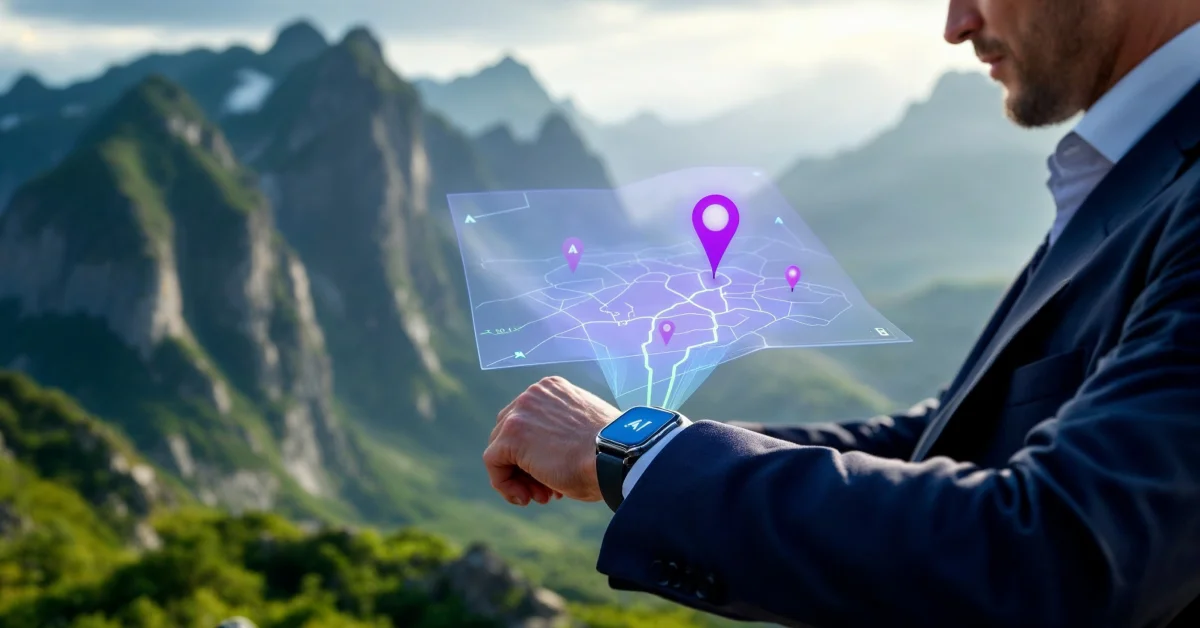
Customers should be studied in order to understand the cause-and-effect relationships in interactions with them and be able to identify development points in time. The best way to understand your customer is to build a “journey map” of the user of your services.
Customer journey is a sequence of expectations, intentions and actions of a potential customer from the moment the need for a product or service arises to the moment of purchase or turning into a brand supporter. By systematizing the Customer journey, a business can see the points of contact with the brand at each stage of the customer journey: where the customer saw the ad, what sites they visited, with whom and where they consulted. A customer journey map can be created based on in-depth interviews with consumers, data from your own team, secret shopper results and observations confirmed by quantitative research.
Unlike a sales funnel, the Customer Journey is not a linear experience; the system is adjusted so that the customer can skip some stages on the way to a sale or return to the previous stage several times. The Customer Journey also covers the customer’s post-sales interaction with the brand, which helps optimize interaction with the next consumers.
A variety of CRM systems with a set of analytical tools help to effectively build a customer journey map, offering automation for the following stages:
- Collecting customer data: The system collects and analyzes both quantitative (mass surveys, sales statistics) and qualitative data (customer interviews, focus groups, customer reviews, observation, mystery shopping). CRM automatically enters data from a chatbot, telephony applications or social networks into the customer database, ensuring omnichannel communication. Tools such as Microsoft Clarity also allow you to systematize information from the identification stages and requests through company websites.
- Identifying the “character”: The system will gradually supplement the customer portrait by analyzing call records, purchase history, payment information, history of requests through certain channels, open rate for marketing emails, frequency and amount of customer purchases, etc.). The “Persona Canvas” method will allow the company to understand the psychology and behavior of the customer, predicting subsequent interactions with them.
- Defining customer journey stages: Integrated AI will build a diagram of possible interactions with the customer, demonstrating in detail how the consumer will go through the purchasing path with existing triggers, barriers and drivers.
- Defining touchpoints: Analytical tools and integrations will help you understand which interactions (touchpoints) with the customer should be paid attention to. For online businesses, these may be interactions through a website, social networks, a call center, etc. For offline businesses, this means stores, advertising banners, service centers, events, etc.
- Understanding the emotions of your customers: Thanks to the automation of data processing, managers have more time for personalized interactions with customers, which will increase the level of user trust and boost their feeling of being valued.
- Defining barriers that may hinder the customer: The combination of analytics and AI will allow the company to quickly predict the challenges that may arise along the customer’s path. These can be technical issues (such as a slow or confusing website) or human factors (such as misunderstandings with a call center operator).
- Map visualization: Automatically distributing data into clear charts and diagrams will clearly show the stages of the customer journey to tailor offers to them in real time.
One of the undoubtedly effective examples of properly orchestrated customer journey map building is the case of the music company Spotify. By focusing on user actions, emotions, and pain points, Spotify improved interaction with the platform, making it more enjoyable and intuitive. The company significantly increased conversion thanks to free trials, personalized recommendations, and affiliate advertising of famous artists. The direct integration function is also effective, allowing the use of music in applications such as Instagram and Facebook. For new customers, Spotify began offering personalized onboarding, compiling playlists and offers for users based on their tastes. Features like Discover Weekly and Release Radar regularly introduce users to new music, while playlists shared with friends fulfill social needs.
Spotify’s focus on improving the stages of the customer journey has led to the following results:
- More than 70% of users say that personalized playlists significantly improve their music experience.
- Conversion rates have increased thanks to targeted offers.
- About 60% of new music discoveries happen through features like Discover Weekly and social integrations.
However, Spotify’s model is not universal. Each business must develop its own system for attracting customers and increasing loyalty.
How to retain an existing customer and attract a new one?
Research shows that the cost of retaining an existing customer can be 5 times less than attracting a new one. And increasing customer retention by 5% can increase revenue by 25-95%. However, a company cannot rely only on regular customers: a growing business must continuously maintain a vector for attracting new customers.
On average, new customers need an acquisition strategy that focuses on building trust, creating awareness and converting leads. CRM helps manage the flow of new contacts and track their readiness to buy. Current customers usually require careful personalization and long-term relationships, where the CRM system provides a detailed analysis of the customer’s history and offers personalized solutions to increase loyalty and sales. At the same time, segmentation and hyper-personalization will be responsible for ensuring that the current customer does not get bored with monotony, and the new customer is assured that your product can be trusted.
Let’s look at the differences in using standard business tools for different types of customers using the SMART CRM platform as an example:
Working with data:
- For new customers: SMART CRM is used at this stage to collect contact information, track initial interactions, and segment leads. Important functions here include marketing automation, sales funnel setup, and tracking click-through rate, conversion rate. CRM integrates with advertising channels (Facebook, Google Ads) to generate leads. The system also offers reporting on the costs and effectiveness of marketing campaigns to attract new customers.
- For existing customers: SMART CRM is a tool for deep personalization of communications, tracking purchase history, support contacts, and interactions with products. Hyper-personalization algorithms are used based on customer data collected in CRM. The emphasis here is on automating retention marketing through email campaigns, loyalty programs, and personalized offers. And thanks to metrics like Lifetime Value, you can draw conclusions about what repeat purchases customers make, for what amount, and who is more promising considering repeat sales or cross-selling.
Content and messages:
- New customers: Marketing for new customers plays an “introductory” role — it is necessary to clearly understand what questions, pain points, and challenges the customer needs to solve. The emphasis is on Unique Selling Propositions and special promotions for newcomers (for example, free trials or discounts on the first purchase). After analyzing the data, the SMART Marketing solution on the SMART CRM platform offers tools for creating “broad” content aimed at segments of potential customers.
- Existing customers: Content for existing customers is based on interaction and experience using the product. Cross-selling and upselling tactics are used here, additional products and improved versions of services are offered. For example, integrations in SMART Marketing allow, based on the data obtained, to conduct trigger campaigns — mailings based on customer behavior (inactivity, abandoned carts).
Segmentation:
- New customers: Leads are primarily segmented based on demographic, geographic, or behavioral characteristics. However, personalized filters in SMART CRM allow you to expand the number of segments to meet your unique business needs. A synchronized database also allows you to automate nurturing until your leads are ready to buy.
- Existing customers: Segmentation is based on a detailed history of interactions: purchases, website visits, product use. An RFM (Recency, Frequency, Monetary) analysis algorithm is used to determine the value of each customer and their propensity to make repeat purchases, after which individual customer journey maps are developed.
Multi-channel and omni-channel:
- New customers: The strategy for new customers emphasizes multi-channel campaigns to ensure maximum reach. This includes contextual advertising, SEO, content marketing, social networks, email, and even offline campaigns. SMART Marketing allows you to integrate different channels into a single platform to track all interactions.
- Existing customers: For existing customers, the focus is on a consistent experience across all touchpoints (omnichannel experience). SMART CRM provides a single source of truth, allowing everyone in the company – from marketer to support – to access complete customer information to offer personalized solutions in real time.
The difference between campaigns for new and existing customers can be seen in the example of Airbnb. To attract new users, the team launched emotionally focused campaigns like “Belong Anywhere” and “Made Possible by Hosts”, using videos and photos that made people want to travel and experience new things. These campaigns aimed to create an emotional connection with potential customers, which helped Airbnb gain 17 million views and new users. For existing customers, Airbnb focused on personalization and offers that improved the repeat experience. For example, campaigns aimed at repeat travel included offers based on users’ past trips. This provided a sense of belonging and local, authentic experiences, which encouraged repeat bookings.
However, advertising works best when it resonates with current social trends in the world. So how can you ensure that your company has tamed the rapid changes in, say, the vastness of social media?
Trends and Tendencies: how to “catch the vibe” of the modern market

Customers like to feel that the brands and companies whose services they use are keeping up with the modern world. But how to achieve this result, given that trends and tendencies are constantly and rapidly changing?
First, you need to be online 24/7. AI helps with this, which can constantly monitor trends and suggest how to integrate them into the product. However, the integration should be “subtle”: you should not annoy customers with incomprehensible slang or “forced modernity”. Advertising usually works well if it is targeted to segments: for example, for current older customers, familiar, comfortable conditions for using the product are offered, and for young people, trendy campaigns with a certain challenge. Here are a few steps a company can take to stay on trend:
- Social media monitoring or “social listening” – integration with social networks will become an indispensable tool in such matters. Choose a CRM with AI algorithms to monitor trends online and adapt your strategies to the data received.
- Identify influencers – people tend to trust people more than ads or advertising flyers. Influencers have a great influence on their followers, because their content is perceived as authentic and close to real-life situations. They help businesses gain organic access to new audiences and increase brand awareness. However, before you involve an influencer in advertising your brand, you should make sure that they have the right audience and that their social values align with your company’s vision.
- Adapt content to trends – of course, simply following trends is not enough, you also need to be able to adapt your products to them. Generative artificial intelligence can help with suggesting ideas, but usually the responsibility for creativity falls entirely on the shoulders of the marketing department. Analytics tools can help evaluate the results of new strategies — for example, A/B testing and gradual scaling will show whether you have managed to catch the necessary “vibe”.
- Automated post scheduling — use scheduling tools to develop a posting schedule in advance. To determine effective posting times, use social media analytics (integrations with Instagram Insights, Facebook Analytics), considering the peak hours of your audience’s activity — usually morning and evening hours. Gradually adjust the plan based on the results.
- Respond to events in real time — it is important for businesses to always be aware of the current state of society. A delayed reaction to an event that is important to your customers can be perceived as ignorance or indifference, which will cause a negative reaction from the audience. However, you should always maintain a balance — it is better to maintain a neutral position in difficult situations or announce that your company is waiting for an up-to-date information about an event, so that your strategies do not seem unethical or insensitive.
Chipotle’s 2019 case proves that using trending social media platforms and algorithms correctly can yield incredible results. Their #GuacDance campaign was one of the most successful on TikTok. It launched on National Avocado Day and encouraged users to dance to a song about guacamole. The trend resulted in the largest single-day guacamole sales in Chipotle history.
Trends like these can be used not only as supplementary marketing, but also as a complete promotion of a new company on the market from scratch. For example, the brand “Nice Shirt. Thanks!” developed its own trend, where they made T-shirts according to customer requests in the comments. Thanks to this engagement, the brand’s account gained 1.5 million views and 370,000 likes, which, accordingly, had a very positive impact on sales.
In both cases, the companies succeeded not only because they correctly assessed the market trends, but also thanks to direct communication with the audience. The voice of the customer, especially in the second case, has become the driving force behind the company’s development.
Measuring the immeasurable: How to determine the success of your company
The goal of customer experience analytics is to study the path of a potential buyer and identify barriers and weaknesses. It allows companies to evaluate not only financial indicators (e.g. ROI, profit), but also other key aspects, such as customer satisfaction, conversion, customer retention, and staff productivity. For example, according to research, companies using metric-based analytics increase efficiency by up to 8% and reduce costs by 10%. Implementing such metrics helps to see weaknesses and increase business profitability. Based on the data collected, a business will be able to build hypotheses and improve the customer experience. What indicators are best to measure? We suggest considering several effective metrics:
- NPS (Net Promoter Score) is a consumer loyalty index that will help assess the attitude of customers towards the company. The simplest option for collecting data is a survey. For example, ask customers how likely they are to recommend the brand to friends or family on a scale of 1 to 10.
- CSAT (Customer Satisfaction Score) is a customer satisfaction index that shows how much your audience likes your product. Ask users how satisfied they are with the service, product or company on a scale of 1 to 10 (or 5). An indicator in the range of 75-85% is considered good. Based on this data, you can adjust marketing strategies and determine which areas need to be improved.
- CLV (Customer Lifetime Value) – the lifetime value of a customer helps you understand how much value one customer will bring to the company over the entire period of cooperation. Based on this data, it is easier to decide which target audience to attract to the business. The formula for calculating CLV is as follows: Customer Lifetime Value = Average profit from a customer for a period (month, quarter, year) x Average customer retention period.
- Churn rate — the percentage of customer churn will tell you why users leave and how to get them back, because such losses are expensive for a business. To calculate the Churn Rate, first select the evaluation period. After its completion, count the number of customers who left and divide by the number of customers at the beginning of the period.
- Retention Rate – the customer retention index will tell you how successfully you are strengthening the loyalty of the audience. To calculate the metric, you need to know how many customers there were at the beginning and end of the period and how many newcomers came. This metric is closely related to the churn rate, because it highlights what percentage of users you can retain.
To avoid analyzing and measuring performance manually, it is better to use out-of-the-box CRM systems with integrated analytics tools. The SMART CRM solution provides, in addition to managing the customer base and sales communications, continuous end-to-end analytics and control of the activity plan, automating all mechanical processes.
The customer journey in business today is not just a path from point A to point B, but a complex map of personal expectations and emotional moments, where every stop matters. And CRM systems are your guide in the world of impeccable customer service. Personalizing the customer experience is a painstaking and detailed matter, but this work always pays off, because a satisfied customer is the best advertisement for any business.
